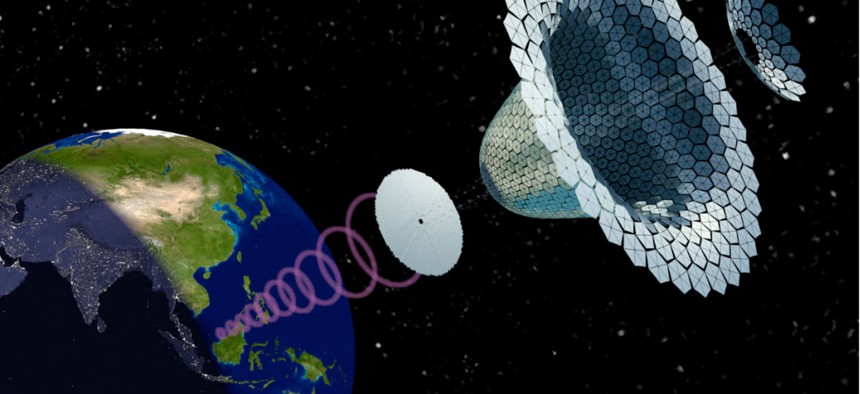NRL project would collect solar power in space
The orbiting solar array could collect solar energy unencumbered by atmosphere, then transmit it to Earth via microwaves.
One way to amp up solar power is to get closer to the sun—as in space, where there are no atmospheric disturbances to get in the way and where spacecraft in geosynchronous orbit can stay within the sun’s rays.
The challenge is in being able to collect enough solar power to make it worth the expense of launching a large solar array into space and then efficiently getting that power transmitted down to Earth.
A government/industry team of scientists led by Dr. Paul Jaffe, a spacecraft engineer at the U.S. Naval Research Laboratory, has been working on solving that challenge and say they hope to demonstrate an orbiting power station within 10 years. And they appear to be making some progress—the project recently was selected from nearly 500 entries as the winner of the Defense Department’s inaugural Diplomacy, Development, and Defense (D3) Innovation Summit Pitch Challenge, according to an ONR release.
"The proposed approach entails collection of solar energy, its conversion to microwave energy, and the wireless transmission of the microwaves to the Earth," Jaffe said in the release. "This offers the benefit of providing base-load power while avoiding diurnal cycles and atmospheric losses often associated with terrestrial solar power."
The idea of going into space to tap solar energy isn’t new—it’s been kicked around since at least the 1970s, and was reportedly proposed by writer Isaac Asimov in the 1940s. The key, Jaffe said in an earlier NRL post, is making sure the power cost per pound is feasible, because of the expense of launching equipment into space.
Keeping components light is important, since the array would be large—about nine times the foot-ball field size of the International Space Station—and would likely be assembled in space by robots. Once collected, the energy could be beamed down to Earth via microwaves (lasers also have been proposed). At the moment, researchers are aiming to have a solar satellite provide power at a cost competitive with terrestrial sources in most places—about 10 cents per kilowatt hour.
Matching what’s already available on the ground might not seem like much of a step forward, but NRL is focusing on supplying forward-deployed areas where power—whether ground-based solar, diesel generators, or fuel delivered over land or through the air—can be difficult, expensive and even dangerous.
Although a working solar energy plant in space may still be years, or even decades, away, NRL isn’t alone in its pursuit. NASA and the Energy Department also have researched the possibility, and Japan, China and India have similar projects underway,
NRL’s partners in its research include the State Department’s Bureau of Energy Implementation, Defense Advanced Projects Agency, Joint Staff Logistics Directorate, Air Force's Air University Center for Space Innovation, and industry stakeholders Mankins Space Technology Inc. and Northrop Grumman.





